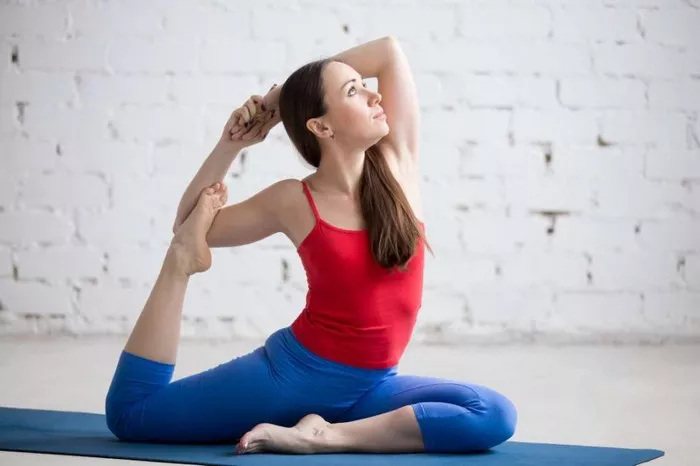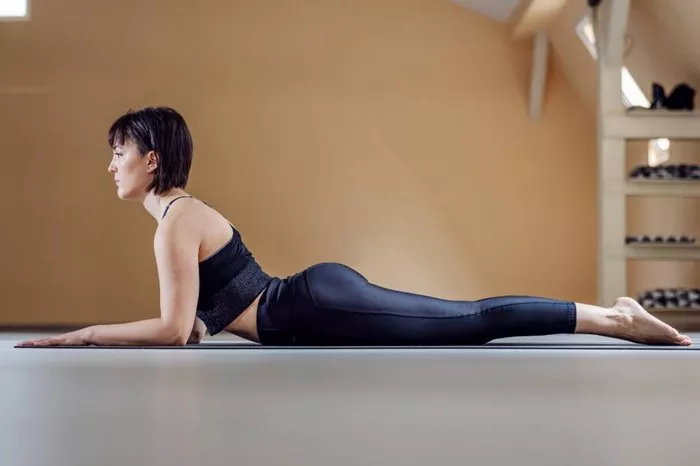Vinyasa yoga, often referred to as “flow yoga,” is a dynamic and increasingly popular style of yoga that emphasizes fluid movement and coordinated breathwork. Derived from the Sanskrit word “nyasa,” meaning “to place,” and the prefix “vi,” meaning “in a special way,” Vinyasa refers to the intentional and fluid sequence of poses that are connected through breath. Unlike other more static forms of yoga, Vinyasa invites practitioners to move continuously from one pose to the next, cultivating both strength and flexibility, while encouraging mindfulness and presence.
This style of yoga incorporates a wide variety of asanas (yoga poses), each with a specific function and intention. The sequence of poses can vary depending on the instructor and class format, but all Vinyasa classes share the core principle of linking movement with breath.
In this article, we will explore the key poses commonly found in Vinyasa yoga, as well as their benefits, alignment cues, and variations. Whether you’re a beginner or an experienced practitioner, understanding these poses and how they flow together will deepen your practice and enhance your overall experience of Vinyasa yoga.
Key Components of Vinyasa Yoga
Before diving into the specific poses, it’s helpful to understand some of the foundational principles that shape Vinyasa yoga.
1. Breath-Synchronized Movement
In Vinyasa yoga, the breath is the guiding force. Every movement is linked with an inhale or exhale, creating a rhythm that connects the body and mind. Inhaling often accompanies an opening or expanding movement (such as lifting the arms), while exhaling corresponds with folding or contracting movements (like forward bends or twists). The focus on breath is not just for physical movement, but also for cultivating mindfulness and presence.
2. Flow and Sequence
Vinyasa emphasizes the continuous flow of movement, creating a seamless transition from one pose to the next. These sequences may vary greatly depending on the class, but they generally start with gentle warm-ups and gradually build in intensity, often reaching a peak before winding down with cooling poses.
3. Alignment and Awareness
Proper alignment in each pose is essential for both safety and effectiveness. In Vinyasa yoga, the goal is to maintain a mindful awareness of your body throughout the sequence. This means staying conscious of your breath, your body’s position in each pose, and how your energy moves through the practice.
4. Variability and Creativity
One of the key aspects of Vinyasa yoga is its flexibility and variety. No two classes are exactly the same, as teachers are encouraged to create their own sequences based on their style and the needs of their students. However, there are certain foundational poses that frequently appear in Vinyasa sequences.
Now, let’s dive into the various poses that are commonly incorporated into a Vinyasa yoga practice.
Core Poses in Vinyasa Yoga
The following is a list of fundamental poses commonly seen in Vinyasa yoga sequences, grouped into categories based on their function and intention. These poses are designed to strengthen, stretch, and balance the body, and each one can be modified to suit different skill levels.
1. Mountain Pose (Tadasana)
Tadasana is often the starting pose for many Vinyasa sequences. Though it might seem simple, it serves as the foundation for all other standing poses. The goal is to stand tall, grounded, and aware of your body.
Benefits:
- Improves posture
- Increases body awareness
- Strengthens legs and core
- Calms the mind
How to Perform Tadasana:
- Stand with feet hip-width apart, grounding all four corners of the feet into the mat.
- Engage the thighs, lift the kneecaps, and activate the core.
- Reach through the crown of your head, lengthening your spine.
- Relax your shoulders down and keep the chest open.
- Arms should be by your sides, with palms facing forward or inward.
2. Downward-Facing Dog (Adho Mukha Svanasana)
A signature pose in Vinyasa yoga, Downward-Facing Dog is both an active stretch and a resting pose that works the entire body. It provides an opportunity to check in with alignment, engage muscles, and focus on breath.
Benefits:
- Stretches the hamstrings, calves, and spine
- Strengthens the arms, shoulders, and core
- Improves circulation
- Calms the mind
How to Perform Adho Mukha Svanasana:
- Start on all fours with your wrists directly under your shoulders and knees under your hips.
- Tuck your toes and lift your hips high, coming into an inverted “V” shape.
- Keep your hands shoulder-width apart and feet hip-width apart.
- Push through your palms and heels, aiming to lengthen the spine.
- Keep your head between your upper arms, ears aligned with your upper arms.
- Gaze can be directed toward your feet or your navel.
3. Plank Pose (Phalakasana)
Plank Pose is a powerful core-strengthening pose that builds stability and endurance. It serves as a transition pose in many Vinyasa flows, often leading to other poses like Chaturanga Dandasana.
Benefits:
- Strengthens the core, arms, shoulders, and wrists
- Improves balance and stability
- Engages the full body
How to Perform Phalakasana:
- Start in a push-up position, with your hands placed shoulder-width apart and fingers spread wide.
- Keep your legs extended straight behind you, with your feet hip-width apart.
- Activate your thighs, draw your belly button toward your spine, and engage your glutes.
- Maintain a straight line from the crown of your head to your heels.
- Avoid letting your hips sag or your shoulders scrunch up toward your ears.
4. Chaturanga Dandasana (Four-Limbed Staff Pose)
Chaturanga is often referred to as a “low plank” and is one of the hallmark poses in a Vinyasa sequence. It builds strength in the arms, core, and back, and is commonly used as a transition between Downward-Facing Dog and Upward-Facing Dog.
Benefits:
- Strengthens arms, shoulders, chest, and core
- Improves posture
- Increases body control
How to Perform Chaturanga Dandasana:
- From Plank Pose, shift your weight forward slightly and lower your body, keeping your elbows close to your ribs.
- Lower your body in one straight line, stopping when your elbows are at a 90-degree angle.
- Keep your core engaged, avoid letting your chest or hips sag toward the ground.
- Press through your palms to protect your wrists.
5. Upward-Facing Dog (Urdhva Mukha Svanasana)
Urdhva Mukha Svanasana is a backbend that opens the chest and strengthens the arms and spine. It is commonly used as a counter-pose to Downward-Facing Dog in Vinyasa flows.
Benefits:
- Opens the chest, lungs, and abdomen
- Strengthens the arms, wrists, and spine
- Improves posture
How to Perform Urdhva Mukha Svanasana:
- From Chaturanga, lower your hips to the floor and straighten your arms, lifting your chest and thighs off the mat.
- Press the tops of your feet into the floor to help lift the legs.
- Keep your shoulders down and away from your ears, and open the chest as you lift.
- Keep your gaze forward or slightly upward.
6. Warrior I (Virabhadrasana I)
Warrior I is a standing pose that strengthens the legs, hips, and arms while stretching the chest and hips. It also improves focus and stability.
Benefits:
- Strengthens the legs, arms, and core
- Stretches the hips and chest
- Improves balance and concentration
How to Perform Virabhadrasana I:
- Start in Downward-Facing Dog and step one foot forward between your hands.
- Rise up, bending your front knee to a 90-degree angle, while keeping your back leg straight and strong.
- Press the outer edge of the back foot into the mat.
- Extend your arms overhead, keeping your shoulders relaxed and palms facing each other.
- Square your hips forward and keep your chest open.
7. Warrior II (Virabhadrasana II)
Warrior II is another foundational standing pose that engages the entire body. It helps to open the hips, strengthen the legs, and improve focus.
Benefits:
- Strengthens the legs, glutes, and arms
- Opens the hips and chest
- Improves stamina and balance
How to Perform Virabhadrasana II:
- From Warrior I, rotate your back foot flat on the mat and open your hips and shoulders to face the long side of the mat.
- Bend your front knee deeply, keeping it aligned with your ankle.
- Extend your arms parallel to the floor, palms facing down.
- Gaze over your front hand and hold the pose for several breaths.
8. Tree Pose (Vrksasana)
Tree Pose is a balancing pose that enhances concentration, coordination, and strength. It is often incorporated into Vinyasa flows to bring awareness to the present moment and improve stability.
Benefits:
- Improves balance and coordination
- Strengthens the legs and core
- Opens the hips and stretches the inner thighs
How to Perform Vrksasana:
- Stand tall in Tadasana and shift your weight onto one foot.
- Place the sole of the other foot on your inner thigh or calf (avoid placing it on your knee).
- Bring your palms together in front of your chest in prayer position or extend your arms overhead.
- Keep your gaze focused on one point in front of you to help maintain balance.
Conclusion
Vinyasa yoga offers a dynamic and invigorating practice that promotes physical and mental well-being. Through the integration of breath and movement, practitioners are encouraged to cultivate presence and mindfulness while moving through a variety of poses. The sequence of poses in Vinyasa yoga can vary, but the fundamental postures discussed above—such as Downward-Facing Dog, Warrior poses, and Plank—serve as the foundation for many sequences.
Whether you are just beginning your journey into Vinyasa yoga or looking to deepen your practice, understanding the functions and benefits of these key poses will support your growth and development on the mat. With consistent practice, you will not only increase your physical strength and flexibility, but also enhance your mental clarity, focus, and sense of peace.
Remember that the essence of Vinyasa is about flow—flow of breath, flow of movement, and flow of energy. Embrace the process and enjoy the journey as you explore the many benefits this transformative practice has to offer.
Related Topics:






















